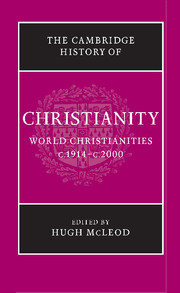Book contents
- Frontmatter
- 1 Introduction
- 2 Being a Christian in the early twentieth century
- PART I INSTITUTIONS AND MOVEMENTS
- PART II NARRATIVES OF CHANGE
- PART III SOCIAL AND CULTURAL IMPACT
- 26 Liturgy
- 27 The ‘other’
- 28 Wealth and poverty
- 29 Male and female
- 30 Christianity and the sciences
- 31 Literature and the arts
- 32 Role models
- 33 Being a Christian at the end of the twentieth century
- Bibliography
- Index
- References
26 - Liturgy
from PART III - SOCIAL AND CULTURAL IMPACT
Published online by Cambridge University Press: 28 March 2008
- Frontmatter
- 1 Introduction
- 2 Being a Christian in the early twentieth century
- PART I INSTITUTIONS AND MOVEMENTS
- PART II NARRATIVES OF CHANGE
- PART III SOCIAL AND CULTURAL IMPACT
- 26 Liturgy
- 27 The ‘other’
- 28 Wealth and poverty
- 29 Male and female
- 30 Christianity and the sciences
- 31 Literature and the arts
- 32 Role models
- 33 Being a Christian at the end of the twentieth century
- Bibliography
- Index
- References
Summary
Writing in 1960 the American Episcopal liturgical scholar, Massey Shepherd, accurately stated, ‘There is no individual who is competent to give sufficient account of the liturgical renewal of our times.’ The twentieth century has witnessed little short of a revolution in terms of worship texts and practices in most Western churches and in those third world churches that were the product of Western missionary movements. From the Roman Catholic church, to Presbyterian and Disciples of Christ, we find new prayer books and texts for public worship; alongside this there have been movements, such as in Korea, Africa and India, to indigenise or inculturate worship, making it less Euro- or north Atlantic-centred, and reflecting something of the religious temperament of the local culture. Some of this work has been the sophisticated product of committees of experts, drawing on a wide knowledge of historical forms of worship. Often the end results in different churches were very similar in shape and content, showing the common assumptions and conclusions of the liturgical movement and ecumenical movement. Some have been more spontaneous, often without a clearly thought out and articulated theology. These latter fall mainly into three categories: the seeker services; the praise and worship movement; and the contemporary worship music industry. It is unlikely that all the endeavours in different churches by different individuals can ever be fully documented. The result, however, is that the face of public worship in the churches at the end of the twentieth century is very different from what it was in 1900. This article will be mainly concerned with the Roman Catholic, Anglican and Reformed churches.
- Type
- Chapter
- Information
- The Cambridge History of Christianity , pp. 469 - 482Publisher: Cambridge University PressPrint publication year: 2006



